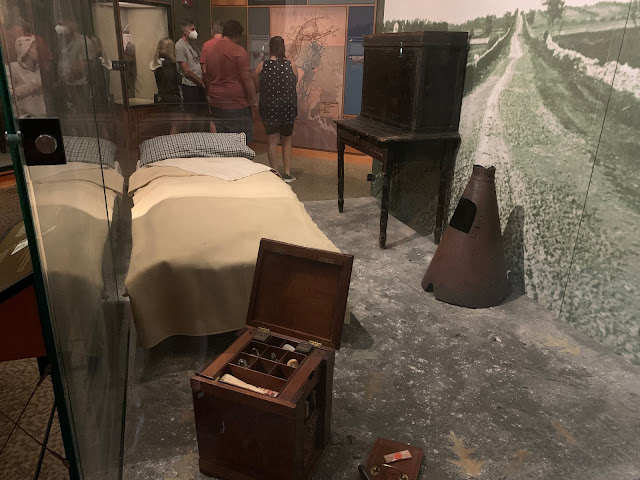The goal for our visit to Pennsylvania was to visit Gettysburg. We'd been here a few times in the past but to be honest, I didn't really have much interest but just went along for the ride. But my interest is much different now. Although to be sure, Ron "encouraged" me to watch the 1993 movie Gettysburg the night before we were planning our visit. Not the most accurate historically but it gave me an overview of what I was going to see the next day.
First up - a movie explaining about the three day battle in July, 1863. Heck, this felt like a review.
From there we moved into the area for the Cyclorama. Before feature films, before IMAX, before virtual reality - there was the cyclorama.
Created by French artist Paul Philippoteaux in 1884, the Battle of Gettysburg Cyclorama depicts the fury of Pickett's Charge during the decisive third day of fighting. Reviews of the time called it "marvelous", "remarkable" and "must be seen". The painting survived years of exhibition, multiple moves, vandalism, fire, cuts and neglect before finding a home in Gettysburg in 1913. Purchased by the National Park Service in 1942, the painting underwent multiple restoration efforts - including a multimillion-dollar restoration from 2004-2008 and now hangs as the centerpiece of the cyclorama building at the Museum & Visitor Center.
With its landscaped foreground and dramatic sound and lighting effects, the Battle of Gettysburg still creates the three-dimensional illusion of being in the midst of the battle. It is an immersive experience that today's visitors call "moving", "riveting" and "breathtaking". The Gettysburg Cyclorama is 377 feet long, 42 feet high and weighs 12.5 tons.
Beginning in 2003, the Gettysburg Cyclorama underwent a thirteen million dollar rehabilitation project. Specialists repaired unstable sections of the canvas and restored original details lost during the numerous repair and preservation attempts on the painting. It was then moved to the new Gettysburg National Military Park Museum and Visitor Center and placed in its own unique viewing auditorium with a restored skyline and foreground. The conserved painting and restored foreground was unveiled to visitors in 2008 during the grand opening of the visitor center.
The photo doesn't do it justice - it really is an incredible experience.
While this is a copy, it is still pretty incredible to see the Emancipation Proclamation.
General John Reynolds, who was commanding the Union first corps, was closest to Gettysburg at the time of General Buford's delaying action. It took the first corps several hours to support Burford's cavalry but once they arrived, his corps went into action immediately. Sadly, General Reynolds was shot in the back of the head by a Confederate sniper shortly after his arrival.
This is what the tavern looked like at the time.
Of course, there were many items pertaining to Abraham Lincoln.
See Lincoln's autograph on the bottom?
The stove, cot, medical chest, and field desk here traveled with General Robert E. Lee during the invasion of Pennsylvania. Lee's modest headquarters were no mark of his importance to the Confederate cause by spring 1863. Southerners' brightest hopes for victory rested not with Jefferson Davis or even the will of the Confederate people but with Robert E. Lee and the Army of Northern Virginia.
Before starting the auto tour of the battlefields, we decided to go to historic downtown Gettysburg to look around and have some lunch. Parking was tough but we were able to find a spot. We had some lunch and when we came out, the heavens had opened and there was quite a storm. Of course, our umbrellas were in the truck about 3 blocks away.
We had to laugh the way all of the visitors were just waiting for an opportunity to make a get away.
We decided a tour, even in the truck, would be miserable so we went back "home" and made plans to come back the next day.























No comments:
Post a Comment